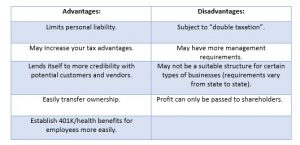C-Corp
 The most common type of corporation is the C-Corporation (C-Corp). Even those who choose to create an S-Corporation start with a C-Corp before making the “S” tax election. A C-Corp shields the personal assets of the business owners from civil judgments. A properly formed and maintained C-Corp offers protection for the personal assets of its shareholders, officers, directors, and employees. There are tax advantages due to deductibles on employee benefits and business expenses.
The most common type of corporation is the C-Corporation (C-Corp). Even those who choose to create an S-Corporation start with a C-Corp before making the “S” tax election. A C-Corp shields the personal assets of the business owners from civil judgments. A properly formed and maintained C-Corp offers protection for the personal assets of its shareholders, officers, directors, and employees. There are tax advantages due to deductibles on employee benefits and business expenses.
Although this structure offers benefits not shared by sole- proprietorships, there is a downside. C-Corporations (C-Corps) pay taxes on the income of the business and then the shareholders pay taxes on the dividends received. Many refer to this as “double taxation”.

To form a C-Corporation the Articles of Incorporation must be filed. The Articles of Incorporation require basic information about the company such as the proposed name, registered agent name and address, and business purpose. Other information, such as director and officer information may also be required.
If you’re not sure where to begin, it can be a little overwhelming. That’s where we come in.
CorpCo® takes care of the preparation and filing of this document and can provide registered agent services in all 50 US States (and the District of Columbia). In addition, we can provide a variety of other services. For example, you may include Good standing, certified copy, or EIN (tax ID) obtainment services with your order.
If you have questions before ordering, please feel free to contact us. One of our friendly representatives will be happy to assist you.
Ready to form your C-Corporation (C-Corp)?
Frequently Asked Questions
What is the organizational structure of a C-Corporation?
The owners of a C-Corporation are called shareholders. The shareholders elect directors, who are responsible for setting the corporate goals and for general management of the corporation. Those directors appoint officers (e.g. President, Vice-President, Secretary, Treasurer) and other managers who are charged with carrying out the daily business and with enacting the directives that are handed down by the directors.
Can the personal asset protection provided by forming a C-Corporation be taken away?
Personal asset protection can be lost if the owners of the corporation do not maintain a proper organizational balance. Shareholders should consult with attorneys, accountants, and/or financial advisors to determine proper handling of corporate/personal income or expenses in order to avoid inappropriate expenditures which may result in a loss of personal asset protection. Furthermore, it is important that the important decisions of the company be properly indicated in the minutes of the corporation, taken at a duly authorized meeting of the board of directors.
The “corporate veil” created by the formation of the C Corporation can also be lost if the business fails to meet the annual requirements of its state of incorporation. CorpCo can help you to meet the annual requirements in your state of organization and will send notification of required annual reporting with the Secretary of State offices as indicated. For more information on annual requirements, please contact us.
What are the main differences between a C-Corporation and an S-Corporation?
C-Corporations file IRS form 1120 to report corporate income to the Internal Revenue Service. The IRS taxes company profits at corporate tax rates and dividends paid to shareholders at individual tax rates. For this reason, you may hear tax professionals refer to “double taxation” of a C-Corporation.
C-Corporations can elect “pass-through” taxation by applying to the IRS for status as a Subchapter S-Corporation (IRS form 2553). The S-Corporation provides the same protection from personal liability. However, owners can report their share of profit and loss in the company on their individual tax returns. The S-Corporation files IRS form 1120S to report income.
S Corporations have a number of restrictions. Most notably, only U.S. citizens or permanent residents may own an S-Corporation. An S-Corporation may not have more than 100 shareholders.
What happens when I order a C-Corp formation from CorpCo?
You will receive confirmation of your order by email. At the same time, CorpCo will receive and review your request for accuracy and will begin preparing the necessary paperwork. CorpCo will draft your formation document and, in many cases, will act as the organizer. The filing is then submitted to the state for processing. If your order includes Express Processing, it will take priority over other routine requests which means a faster processing time. While turnaround times vary greatly from state to state, routine processing is generally about 7-10 days. With CorpCo’s Express Processing, orders can be completed in as little as 24-48 hours. Once your company has been approved by the state, CorpCo will send confirmation of filing which usually includes a file-stamped copy of the filing and an instrument of organization. If your company formation package includes a corporate kit, CorpCo will ship the kit under separate cover within 3-5 days of company formation.
What is required to keep my company active?
Each state has varying requirements for keeping the company active/in good standing. Most will require some sort of annual filing which may require company details and usually involve a filing fee. In some states, failure to file an annual tax return may also result in the company becoming inactive (not in good standing).
What is required to form a C-Corporation?
In order to form a C-Corporation, Articles of Incorporation (sometimes referred to as a Certificate of Incorporation) must be filed with the state where the C- Corporation is to be formed. The Articles of Incorporation will require basic information about the company such as the proposed name, registered agent name and address, principal office address, and business purpose. CorpCo takes care of the preparation and filing of this document and can provide registered agent services in all 50 US States as well as the District of Columbia.
